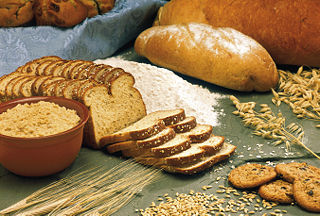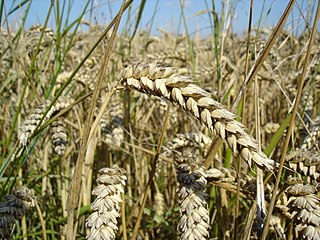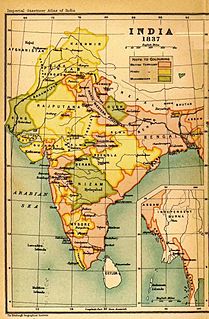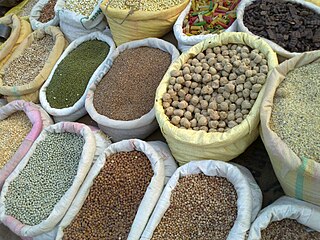
A cereal is any of the edible components of the grain of cultivated grass, composed of the endosperm, germ, and bran. Cereal grains are grown in greater quantities and provide more food energy worldwide than any other type of crop and are therefore staple crops. Edible grains from other plant families, such as buckwheat (Polygonaceae), quinoa (Amaranthaceae) and chia (Lamiaceae), are referred to as pseudocereals.

Wheat is a grass widely cultivated for its seed, a cereal grain which is a worldwide staple food. The many species of wheat together make up the genus Triticum; the most widely grown is common wheat.

The oat, sometimes called the common oat, is a species of cereal grain grown for its seed, which is known by the same name. While oats are suitable for human consumption as oatmeal and rolled oats, one of the most common uses is as livestock feed. Oats are a nutrient-rich food associated with lower blood cholesterol when consumed regularly.

Breakfast cereal is a breakfast food made from processed cereal grains and often eaten for breakfast, primarily in Western societies. It is most often mixed with milk, but can also be eaten with yogurt or fruit. Some companies promote their products for the health benefits from eating oat-based and high-fiber cereals. In the United States, cereals are often fortified with vitamins but can also lack many of the vitamins needed for a healthy breakfast. A significant proportion of cereals are made with high sugar content. Many breakfast cereals are produced via extrusion. The breakfast cereal industry has gross profit margins of 40–45%, 90% penetration in some markets, and steady and continued growth throughout its history. The number of different types of breakfast cereals in the U.S. has grown from 160 (1970) to 340 (1998); forecasted trend for 2012 was 4,945 (2012). In this highly competitive market, breakfast cereal companies have developed cereals in an ever-increasing number of flavors. Although many plain wheat and oat based cereals exist, other flavors are sweet. Some of the most popular brands include freeze-dried fruit and others are flavored like dessert or candy.

A bushel is an imperial and US customary unit of weight or mass based upon an earlier measure of dry capacity. The old bushel was equal to 2 kennings (obsolete), 4 pecks or 8 dry gallons and was used mostly for agricultural products such as wheat. In modern usage, the volume is nominal, with bushels denoting a mass defined differently for each commodity.
Special K is a brand of breakfast cereal and meal bars manufactured by Kellogg's. The cereal was introduced to the United States in 1955. It is made primarily from grains like lightly toasted rice, wheat and barley. Special K used to be marketed primarily as a low-fat cereal that can be eaten to help one lose weight.

Threshing is the process of loosening the edible part of grain from the husks and straw to which it is attached. It is the step in grain preparation after reaping and before winnowing, which separates the grain from the chaff. Threshing does not remove the bran from the grain.

A whole grain, also called a wholegrain, is a grain of any cereal and pseudocereal that contains the endosperm, germ, and bran, in contrast to refined grains, which retain only the endosperm.
Riceland Foods, Inc. is a farmer-owned agricultural marketing cooperative and the world's largest miller and marketer of rice. The company was founded in 1921 with headquarters in Stuttgart, Arkansas. Riceland owns and operates seven rice mills, including the largest rice mill in the world, located in Jonesboro, Arkansas. More than two-thirds of Riceland’s business is delivering, milling, storing, marketing and distributing rice.
The grain trade refers to the local and international trade in cereals and other food grains such as wheat, maize, and rice.
Arrowhead Mills is a brand of organic baking mixes, grains, cereals, and nut butters.
Winchester measure is a set of legal standards of volume instituted in the late 15th century (1495) by King Henry VII of England and in use, with some modifications, until the present day. It consists of the Winchester bushel and its dependent quantities, the peck, (dry) gallon and (dry) quart. They would later become known as the Winchester Standards, named because the examples were kept in the city of Winchester.
The hobbit is a unit of volume or weight formerly used in Wales for trade in grain and other staples. It was equal to four pecks or two and a half bushels, but was also often used as a unit of weight, which varied depending on the material being measured. The hobbit remained in customary use in markets in northern Wales after Parliament standardized the Winchester bushel as the unit of measure for grain, after which courts gave inconsistent rulings as to its legal status.
Before the introduction of the Metric system, one may divide the history of Indian systems of measurement into three main periods: the pre-Akbar's period, the period of the Akbar system, and the British colonial period.

The candy or candee, also known as the maunee, was a traditional South Asian unit of mass, equal to 20 maunds and roughly equivalent to 500 pounds avoirdupois (227 kilograms). It was most used in southern India, to the south of Akbar's empire, but has been recorded elsewhere in South Asia. In Marathi, the same word was also used for a unit of area of 120 bighas, and it is also recorded as a unit of dry volume.

A grain is a small, hard, dry seed, with or without an attached hull or fruit layer, harvested for human or animal consumption. A grain crop is a grain-producing plant. The two main types of commercial grain crops are cereals and legumes.
In agriculture, grain quality depends on the use of the grain. In ethanol production, the chemical composition of grain such as starch contents is important, in food and feed manufacturing, properties such as protein, oil and sugar are significant, in milling industry soundness is the most important factor to consider and for seed producer, the high germination percentage and seed dormancy is the important feature to consider, for consumers the properties like color and flavor will be important.

The production of corn plays a major role in the economy of the United States. The US is the largest corn producer in the world, with 96,000,000 acres (39,000,000 ha) of land reserved for corn production. Corn growth is dominated by west/north central Iowa and east central Illinois. Approximately 13% of its annual yield is exported.

A staple food, food staple, or simply a staple, is a food that is eaten routinely and in such quantities that it constitutes a dominant portion of a standard diet for a given people, supplying a large fraction of energy needs and generally forming a significant proportion of the intake of other nutrients as well. A staple food of a specific society may be eaten as often as every day or every meal, and most people live on a diet based on just a small number of food staples. Specific staples vary from place to place, but typically are inexpensive or readily available foods that supply one or more of the macronutrients needed for survival and health: carbohydrates, proteins, and fats. Typical examples include tubers and roots, grains, legumes, and seeds.
The Exchequer Standards may refer to the set of official English standards for weights and measures created by Queen Elizabeth I, and in effect from 1588 to 1826, when the Imperial Units system took effect, or to the whole range of English unit standards maintained by the Court of the Exchequer from the 1200s, or to the physical reference standards physically kept at the Exchequer and used as the legal reference until the such responsibility was transferred in the 1860s, after the Imperial system had been established.












